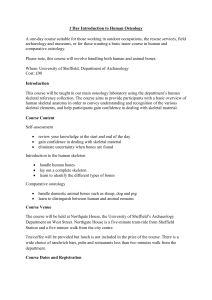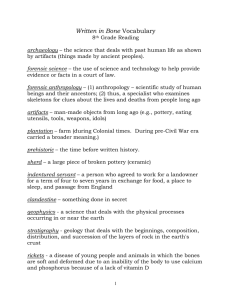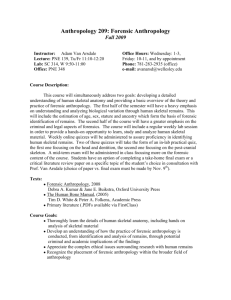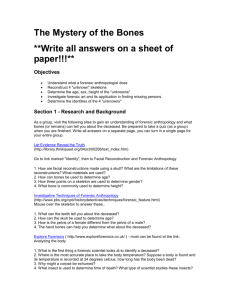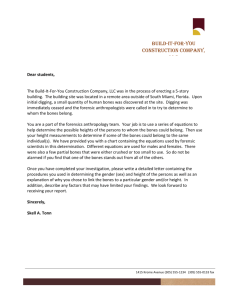ANTH 209
advertisement
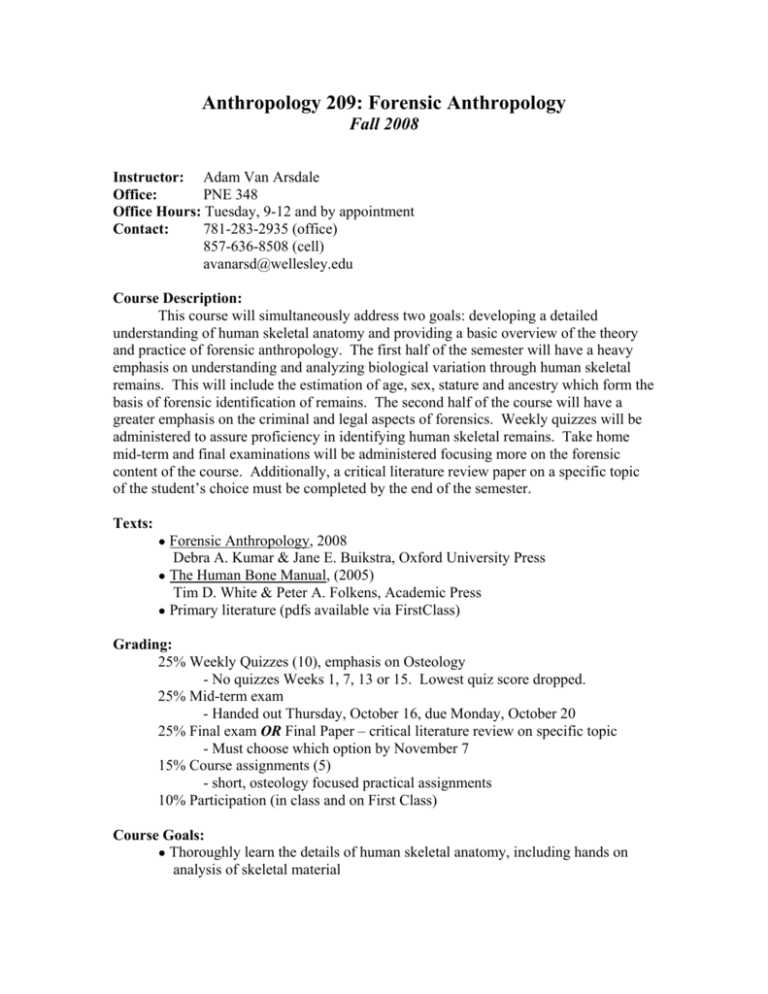
Anthropology 209: Forensic Anthropology Fall 2008 Instructor: Adam Van Arsdale Office: PNE 348 Office Hours: Tuesday, 9-12 and by appointment Contact: 781-283-2935 (office) 857-636-8508 (cell) avanarsd@wellesley.edu Course Description: This course will simultaneously address two goals: developing a detailed understanding of human skeletal anatomy and providing a basic overview of the theory and practice of forensic anthropology. The first half of the semester will have a heavy emphasis on understanding and analyzing biological variation through human skeletal remains. This will include the estimation of age, sex, stature and ancestry which form the basis of forensic identification of remains. The second half of the course will have a greater emphasis on the criminal and legal aspects of forensics. Weekly quizzes will be administered to assure proficiency in identifying human skeletal remains. Take home mid-term and final examinations will be administered focusing more on the forensic content of the course. Additionally, a critical literature review paper on a specific topic of the student’s choice must be completed by the end of the semester. Texts: ● Forensic Anthropology, 2008 Debra A. Kumar & Jane E. Buikstra, Oxford University Press ● The Human Bone Manual, (2005) Tim D. White & Peter A. Folkens, Academic Press ● Primary literature (pdfs available via FirstClass) Grading: 25% Weekly Quizzes (10), emphasis on Osteology - No quizzes Weeks 1, 7, 13 or 15. Lowest quiz score dropped. 25% Mid-term exam - Handed out Thursday, October 16, due Monday, October 20 25% Final exam OR Final Paper – critical literature review on specific topic - Must choose which option by November 7 15% Course assignments (5) - short, osteology focused practical assignments 10% Participation (in class and on First Class) Course Goals: ● Thoroughly learn the details of human skeletal anatomy, including hands on analysis of skeletal material Course Goals: (continued) ● Develop an understanding of how the practice of forensic anthropology is conducted, from identification and analysis of remains, through potential criminal and academic implications of the findings ● An appreciation of the ethical issues surrounding research with human remains First Class: The First Class site for this course will serve as the primary means of out-of-class communication as well as a storage location for course resources. An introduction to the site and its resources can be found on the main page of the conference. Concerns: If you have any concerns regarding your ability to complete the assignments of the course or trouble understanding specific concepts, I am always available for consultation. In addition to my office hours I can be reached with regularity via e-mail (please only call my cell phone in case of emergency). Assistance is also available for students through the PForzheimer Learning and Teaching Center. All work in this class is subject to the Wellesley Honor Code. While students are encouraged to discuss the course materials and assignments both in and out of class, all of your work must reflect your own independent efforts. All assignments must be turned in on time. Unless approval is granted from Prof. Van Arsdale, no late assignments will be accepted. No extra credit will be available for this course. SYLLABUS (subject to change) Week 1: Introduction/What is Forensic Anthropology? Thursday, September 4 – First day of class Readings: • Ch. 1 K&B (1-22) • Ch. 1 W&F (1-6 • Walker (2000), “Bioarchaeological ethics”. From Biological Anthropology of the Human Skeleton, Wiley Liss 3-39. Week 2 (Sept. 8-12): Bones and Biological Variation Lab session, Introduction to the bones (Thursday Sept. 11, SC314) Readings: • Ch. 5 K&B (115-153) • Ch. 4 W&F (31-48) Bones: Anatomical Terminology/ Cranium General bone terminology, Frontal, Parietals (Ch. 6, Ch. 7.1-7.6) **First Osteology quiz, to be completed online by Friday 5pm** Week 3 (Sept. 15-19): Estimating Age Readings: • Ch. 19.1-19.3 W&F (359-385) • Lovejoy et al. (1985), “Multifactorial determination of skeletal age at death”. American Journal of Physical Anthropology 68:1-14 Bones: Cranium Temporals, Occipital, Sphenoid, Auditory Ossicles (7.8-7.10, 7.19) **Osteology quiz, to be completed online by Friday 5pm** Week 4 (Sept. 22-26): Estimating Sex and Stature Lab Session, Sexing skeletal remains (Thursday Sept. 25, SC314) Readings: • Ch. 19.4-19.5 W&F (385-400) • Trotter & Gleser (1952), “Estimation of stature from long bones of American whites and negroes”. American Journal of Physical Anthropology 10:463-514. • Phenice (1969), “A newly developed visual method of sexing the Os Pubis”. American Journal of Physical Anthropology 30:297-302. Bones: Cranium Maxillae, Pallatines, Lacrimals, Nasals, Ethmoid, Vomer, Nasal Conchae (Ch. 7.11-7.18) **Osteology quiz, to be completed online by Friday 5pm** Week 5 (Sept. 29-Oct. 3): Pathology and Trauma Readings: • Ch. 6 K&B (154-188) • Ch. 17 W&F (309-332) Bones: Mandible, cranium review Mandible (Ch. 7.20) **Osteology quiz, to be completed online by Friday 5pm** Week 6 (Oct. 6-10): Taphonomy Lab session, bones of the skull and teeth (Thursday Oct. 9, SC314) Readings: • Ch. 7 K&B (189-207) • Ch. 2 W&F (7-20) Bones: Teeth Incisors, Canines, Premolars (Ch. 8) Molars, Deciduous teeth (Ch. 8) **Osteology quiz, to be completed online by Friday 5pm** Week 7 (Oct. 13-17): Osteology Review Monday October 13 (NO CLASS – FALL BREAK) **MID-TERM passed out Thursday, due Monday Oct. 20 (in class) Week 8 (Oct. 20-24): Personal Identification, Part I Lab session, bones of the upper body (Thursday Oct. 23, SC314) Readings: • Ch. 8 K&B (208-238) • Ch. 19.6-19.9 W&F (400-411) Bones: Upper Postcranial Skeleton Hyoid, Vertebrae, Sternum, Ribs (Ch. 9-10) **Osteology quiz, to be completed online by Friday 5pm** Week 9 (Oct. 27-31): Personal Identification, Part II Readings: • Sun et al. (2003) “Global genetic variation at nine short tandem repeat loci and implications on forensic genetics”. European Journal of Human Genetics 11:39-49. • Shriver & Kittles (2004) “Genetic ancestry and the search for personalized genetic histories”. Nature Reviews Genetics 5:610-617. Bones: Upper Postcranial Skeleton Clavicle, Scapula, Humerus, Radius, Ulna (Ch. 11-12) **Osteology quiz, to be completed online by Friday 5pm** Week 10 (Nov. 3-7): The Medico-Legal System Readings: • Ch. 2 K&B (23-43) • Ch. 3 W&F (21-30) Bones: Pelvis Sacrum, Coccyx, Os Coxae (Ch. 14) **Osteology quiz, to be completed online by Friday 5pm** **Final decision on Final Paper/Final Exam must be made by Friday, 11/7** Week 11 (Nov. 10-14): Evidence & The Judicial System Readings: • Ch. 3 K&B (44-64) Bones: Lower Limb Femora, Patellae, Tibiae, Fibulae (Ch. 15) **Osteology quiz, to be completed online by Friday 5pm** Week 12 (Nov. 17-21): Crime Scene Investigation, part I Lab session, Sexing and assessing age with the pelvis (Thursday Nov. 20, SC314) Readings: • Ch. 4 K&B (65-99) Bones: Hands Carpals, Metacarpals, Phalanges (Ch. 13) **Osteology quiz, to be completed online by Friday 5pm** Week 13 (Nov. 24-28): Crime Scene Investigation, part II Thursday, November 27 (NO CLASS – THANKSGIVING) Readings: • Ch. 4 K&B (99-114) Bones: Feet Tarsals, Metatarsals, Phalanges (Ch. 16) Week 14 (Dec. 1-5): Mass Death and Human Rights Lab session, Bones of the lower body (Thursday, Dec. 4, SC 314) Readings: • Ch. 9 K&B (239-257) • Juhl & Olsen (2006), “Societal safety, archaeology and the investigation of contemporary mass graves”. Journal of Genocidal Research 8:411-435. **Final Osteology quiz, to be completed online by Friday 5pm** Week 15: Developing Biohistories Monday, December 8 (FINAL CLASS) Readings: • Ch. 10 K&B (258-281) • Ch. 19.10-19.11 W&F (411-418)
